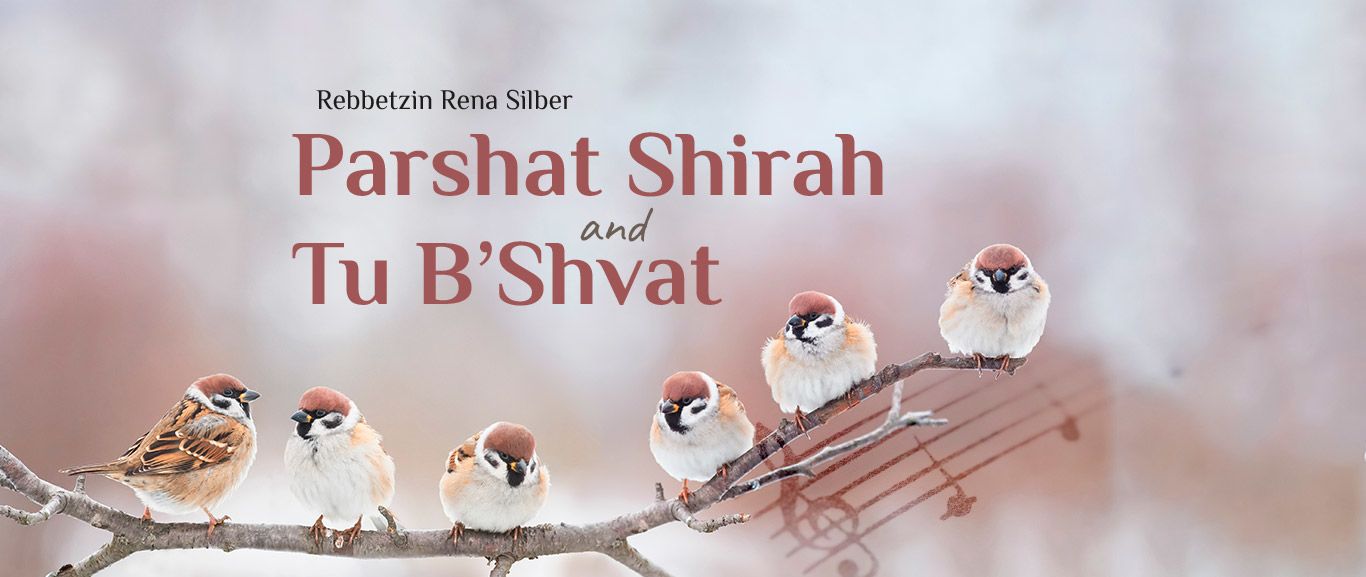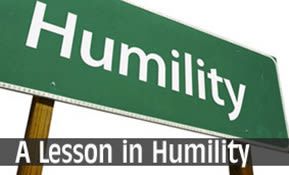
Parshat Shirah and Tu B’Shvat
What's the connection among Parashat Beshalach, Parshat Shirah, Tu B'Shvat, and Shovavim? RENEWAL! We are in a time of renewal for trees and for every Jew.

The Gemara in Rosh HaShanah teaches, “The first day of Shvat is the Rosh HaShanah for the Tree, as per the words of Beit Shammai. Beit Hillel says [it falls on] the fifteenth of the month.” The wording of the Gemara leaves it unclear as to which is the correct date for the New Year for Tree. In actuality, we pasken, define a halachah or rule, that the fifteenth day is the Rosh HaShanah La’Ilan (the New Year for the Tree). Still, we search for the underlying message in this Gemara that is relevant to us.
Renewal of Nature
The “Tu” of Tu B’Shvat refers to the letters Tet-Vav (ט”ו) whose sum is fifteen. The Gemara teaches that on the fifteenth day of Shvat the majority of rain has already fallen in Eretz Yisrael, and the fruit trees begin the process of renewal. The sap, which is the blood of the tree, carrying the life force of nutrition to the tree, begins to rise. This life force, called saraf (שרף) in the Gemara, begins its miraculous anti-gravitational journey upward, from the roots of the tree, up the bark, and then out to the branches where it begins the process of revival; buds begin to sprout, eventually bringing flowers and fruit. The entire process, so hidden from man’s eye and so mysterious, begins on Tu B’Shvat.
A Beautiful Etrog – Repairing the Heart
The Bnai Yissachar points out that the Gemara calls this day “Rosh HaShanah La’Ilan,” the Rosh HaShanah for the singular tree, and not as popularly thought, Rosh HaShanah LaIlanot, all trees. The Gemara explains that the tree it is referring to is the Etrog Tree, the only tree with which we currently fulfill a Torah law. The Bnai Yissachar says that that is the reason there is a custom to daven on Tu B’Shvat for a beautiful and perfect etrog for the following Sukkot.
Of the four species taken on Sukkot, the etrog relates to the heart. In davening for a kosher and perfect etrog, we can extend our prayers to include repairing and elevating our own heart, the seat of love and emotion. Patach Eliyahu explains that the heart is the seat of the sefira of Binah, understanding. Therefore, Shlomo HaMelech (King Solomon) asked for an understanding heart, and we can echo his prayer on Tu B’Shvat. When we understand what another person is going through, it is easier to open our hearts to them in love and acceptance. R’ Yaakov Herman who lived in New York at the turn of the century was famous for hospitality. He and his family fed and sheltered many homeless undesirables, and cared for many unbalanced, abandoned Jews. The beggars often made his Shabbat table rowdy and messy. When asked how he had so much patience for these people, he said, “When you have rachmanut (pity), you don’t need savlanut (patience).”
Prayers for Beauty, Joy, and Wealth
The Jewish woman is also from the sefira of Binah, as we are taught, “Binah is Ima (mother).” Our prayers can thus extend to include the desire of the Jewish woman to be actualized, to be beautiful in the eyes of all who see her. The Gemara teaches that all Jewish women are naturally and inherently beautiful, but poverty – poverty of the spirit – disfigures them, and destroys the beauty of emuna and bitachon and their faces. Poverty in Torah knowledge and mitzva observance obliterates her natural radiance. The prayer of Tu B’Shvat can include the bakasha (request) to be beautiful on all levels.
Extending this concept even further, Knesset Yisrael, the Jewish Nation, often described as Hashem’s bride, is inherently beautiful, as it says in Shir HaShirim (4:7): “U’Mum Ayn Bach – only the test of galut – exile – disfigures our Nation.” We can therefore daven to be a perfect etrog, Pri Eytz Hadar.
Further, we are actually encouraged to daven for parnasa, a livelihood, on Tu B’Shvat. The date given for this Yom Tov in the Gemara is Chamisha Asar B’Shvat (the fifteenth of Shvat). The Rebbe from Sadigur teaches that Chamisha is the rearrangement of the letters Simcha, and Asar refers to Osher, wealth. We are able to thus extend our tefilla to increase our beauty by receiving joy and wealth. Wealth is the freedom to serve Hashem without financial worries. Although the test of wealth is more difficult than the test of poverty, we ask be granted sufficient wealth to serve Hashem with joy.
An Inner Fire – Living Inspired
As mentioned above, the word used in the Gemara for the sap of the tree is saraf (שרף). The Vishnitzer Rebbe teaches that this word is connected to the idea of burning, and of warmth. He says that we must begin to warm up our hearts in our Avodat Hashem. We have to be on fire, and to internalize that Hashem is the sole source of our fire. Through living inspired we are able to transfer our understanding of Torah to others. Most important of all, through living inspired we are able to kindle the fire and life of Torah in our children’s hearts.
Rearranging the letters and vowels of the word SaRaF (שרף) can create the word PeSheR (פשר) , which means that something is watered down, diluted, or compromised. Holy fire will only penetrate those Jews who are truly alive with the joy inherent in Torah. However, when Torah life is lived with inappropriate compromises, without inspiration, it just doesn’t satisfy the souls of this generation. Inspiration itself is simple, uncomplicated. It is born when we just keep the simplest mitzvot of emuna (faith), simcha (happiness), tzeddaka (charity), and kedusha (holiness). We are bidden to live every moment with awareness, love and awe. Simple, albeit, but not necessarily easy. Yet this is our fate, our greatness, our responsibility and our capability.
Splitting of the Sea – Blessing of Spiritual Wealth
Shabbat Parshat Beshalach is traditionally called Shabbat Shira because in the parsha we read of the Splitting of the Red Sea and the subsequent Song of Joy that burst forth from the Children of Israel. The Gemara says that every Jew was given the incredible and almost infinite blessing of spiritual wealth as they saw the miracles of the Splitting of the Red Sea, along with the immense physical wealth garnered from the Egyptians. The natural response of a properly aligned Jew, who is supplied with all the gifts necessary for the soul, is to burst into song. This is what happened to us, and we reached the highest levels of prophesy possible for individuals.
Rav Aviner teaches that even those who were not personally worthy of such a high level of revelation and clarity were given this prophecy as a free gift, and so they too were able to join with the majority of Jews who had rightfully earned the revelation as a result of their deep faith in Hashem. Similarly, we connect ourselves to those hidden and revealed individuals of this generation who are doing the immense spiritual work necessary to bring about the Redemption, and hope to be redeemed in their merit.
The Gemara teaches that finding and continual unity of a zivug emet (true marriage partner) and parnasa, earning a livelihood, are in the same category as the miracles of Kriyat Yam Suf, the Splitting of the Red Sea. Marriage, parnasa, and Kriyat Yam Suf are all miraculous events, above nature.
The ten plagues that took place in Egypt were done within the context of natural events. No new creature was formed, and although the events were above nature, there was still the possibility of rationalization. Not so with the Splitting of the Yam Suf. The events, witnessed by millions, and which led to the final destruction of ancient Egypt, defied any natural law. This first transformational miracle was so clear and strong that it embedded emuna into the hearts of the Jewish people; faith in Hashem and in His servant, Moshe Rabbeinu (Moses).
Restoring the Soul – Tefilla and Teshuva
We are taught that Hashem likewise intervenes above the rules of nature to unite a person with the missing half of his soul. Two parts of one soul need to come together to finish their individual mission in this world. The Midrash teaches that when the marriage between Ruth and Boaz needed to take place, Hashem turned the world upside down to bring them to the right place at the right time. Had they been at different ends of the planet, Hashem would have found a way to bring them together.
Parnasa is about finding the lost objects that belong to our souls and using them to serve Hashem. The Tzaddikim teach that our parnasa, our sustenance, is showered down to us. Yet, because of various factors, we don’t always receive our rightful allotment. One possibility is that our vessel has not sufficiently expanded to receive Hashem’s bounty. Rebbe Natan of Breslev teaches that the simple remedy for this is tefilla, prayer, which creates the vessels needed to receive and contain the blessing. Another reason why we might not receive Hashem’s bounty is that we don’t consider ourselves sufficiently worthy; we block the blessing from entering our lives. Rebbe Nachman teaches that a Jew needs to believe in himself and in his capacity for greatness. Sometimes we make mistakes, aveirot. When we do something wrong, it creates a barrier between us and Hashem. The remedy for this is teshuva, repentance.
Shovavim – Days of Self-Evaluation
These weeks of Shovavim (the acrostic formed from the first letters of the first six Torah readings of the book Shemot, which we read during these weeks) are specifically formulated for teshuva. In fact, according to the Vishnitzer Rebbe, part of the original discussion between Beit Shammai and Beit Hillel is about what should be the impetus to spark us to teshuva. Shammai held that our strength lies in our potential. We must delve into our souls until we reach the deepest and highest point and from there attach ourselves and our thoughts to Hashem. If world events and our personal life are difficult or awesome, we should retreat to the place of humility, glean the energy from these occurrences, and utilize that energy to bind ourselves to Hashem.
Hillel preferred to work with the person and situation as they actually are, with the understanding that not every one lives up to their full potential. He preferred our coming close to Hashem through joy. Although he himself was extremely poor, he taught that the way to come close to Hashem was through receiving His blessings, being humbled by these undeserved blessings, and then returning to Hashem from gratitude. Indeed, shalom (peace) is made between these two ideas of Shammai and Hillel through Aharon HaKohen (Aaron the Priest), who represents gratitude and humility bound together with glory and wealth.
The Rosh HaShanah La’Ilan is a day when the Jew, the tree that Hashem has planted in this world, goes through a self evaluation: How creative have I been? How much fruit have I produced? How much shade have I provided? Has my will bent to the will of my Creator? Are my roots deep enough? What can I do to improve all of the above?
Three Time Periods of Redemption
The Zohar teaches that the world is divided into three eras: two thousand years of chaos – before the giving of the Torah; two thousand years of Torah; and the final two thousand years of Mashiach. This division is echoed in both our individual lives as well as in the cycle of the year. There are three time periods comprising of four months each. Therefore, Shvat is the beginning of the second time period of the year.
To return to our original Gemara, “The first day of Shvat is the Rosh HaShanah for the Tree, as per the words of Beit Shammai. Beit Hillel says [it falls on] the fifteenth of the month.” Shammai said that the Rosh HaShanah for the Tree is on the first of the month, exactly four months after Rosh HaShanah and which is a time of judgment. Hillel says it is on the fifteenth, which corresponds to four months from Sukkot and the corresponding surge of blessings for the Jewish people.
The Shem MiShmuel teaches that an individual’s lifeline, is also divided into three time periods. The first twenty years parallel the years of chaos. Here, we are given the tools with which to work and we begin to awaken to the concept of responsibility. The halacha is that a person is not liable to punishment until age twenty, when full understanding is developed. Age twenty until age forty is the time paralleling Torah. It is then that we put in the effort needed to understand life, to work out our rules of life, to decide between holy and profane. We raise our families and are quite busy. From forty to sixty we enter into the Mashiach era of life. This is the best part of life, we see the results of our labors, we have wisdom and experience. He continues that the years sixty until seventy are based on the previous sixty years. They don’t create any new chidushim (insights). He quotes his grandfather the Kotsker Rebbe, who interpreted the teaching of Chazal, that ‘the elderly become like monkeys,’ to mean that just as a monkey imitates, so do the elderly imitate their prior life. A wise person grows wiser, a fool grows even more foolish.
The year is patterned the same way. The first third of the year, from the fifteenth of Tishrei (according to Hillel) until Shvat, we are given the tools needed for the entire year. The full integration of the awesome Divine Service of Tishrei occurs in Shvat. The middle third of the year, Shvat until Sivan, is the time of work. Our major redemption holidays of Tu B’Shvat, Purim, Pesach and Sefira (and according to Beit Hillel, Shavuot) occur during this time. The final third of the year which includes Sivan, Tamuz, Av and Elul, is designated as the Mashiach part of the year. In the place of the greatest holiness lurks the potential for the greatest impurity. This describes the final months of our past years, when the agony we suffer of Mashiach’s delay in coming and being revealed gives birth to the fast days of Tamuz and Av. Yet our Masters have taught us that these days will turn into days of rejoicing that will surpass anything we have experienced.
Eating as Divine Service
From the Sefer HaYetzirah we learn that the month of Shvat is particularly suited to repairing the act of eating. This week’s parsha discusses the highest level of eating, the Heavenly food called mon. The mon was about faith. We were given rations for one day at a time and were not permitted or able to save from one day to the next. Eating became a form of Divine Service, not just a physical function, and reflected our spiritual state. The mon fell close to the tents of those who had full faith that Hashem provides. The shakier our emuna, the farther the Jews in the desert had to walk to collect their mon. The more they associated eating and the mon with Hashem, the less they needed to do to prepare it for consumption. The further they were from the holiness of the mon, the more they had to process it before they could eat it.
Most of all, the mon was connected to Shabbat. It never fell on Shabbat. Instead, a double portion fell on erev Shabbat which we commemorate today by using two challot (loaves) at our Shabbat meals.
Eating is a necessary process that keeps our souls connected to our bodies. It should be a humbling experience, a reminder of our similarity to the animal world. Angels don’t eat, and men, on the level of angels, barely eat. Moshe Rabbeinu did not eat for three forty-day cycles. Rebbe Nachman once said that if he could reveal all the Torah that he knew, it would be so satisfying that we would be able to live on the Torah alone and not need physical food. Yet, eat we must, but we must not get lost in our food and forget its purpose.
We eat to stay alive and to serve Hashem. In His kindness, He has made eating a pleasant experience. He has permitted us to eat of His animals, and even has planted sparks of holiness within them so that our eating can raise these sparks and at the same time keep us protected and elevated.
Elevating the Divine Sparks
There are many stories of Tzaddikim who could see the souls within their food that required a spiritual remedy. The Divine service of the tzaddik was to use the energy provided by the food to elevate these souls. The blessing recited before eating requests permission and the after-blessing says thank You. But perhaps just as important could be the humility with which we eat, being ‘grateful’ to the food that ‘allows’ us to eat it. We could turn this gratitude into something meaningful by taking whatever good energy we get after the eating and turning it into a minute of Torah thought, a quick niggun (tune), a compliment to the hostess, a thoughtful bracha achrona (after-blessing). We can then further ‘thank’ the animal whom we have just eaten by doing some mitzva or by just living the Torah, and thus elevating the animal’s status to that of mitzva. Eating with this intent can be transformative.
We are taught this lesson by the conversation of Dovid HaMelech (King David) with the frog, as recorded in Perek Shira. Among other things, the frog tells Dovid HaMelech that its greatness is its willingness to give its life away so that the water creatures can eat it. This is part of its Song to Hashem.
Repairing our eating, the integration of mon, the elevation of fruits, the restoration of true soul mates, the soul bursting into song, the prayer for our children, and the restoration of our spiritual and physical wealth are the gifts of this Shabbat Shira – Tu B’Shvat. May we merit to create the proper vessels to receive and contain and assimilate all this into our lives.












Tell us what you think!
Thank you for your comment!
It will be published after approval by the Editor.